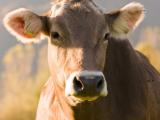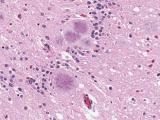Nov 22, 2005 (CIDRAP News) A second case of variant Creutzfeldt-Jakob disease (vCJD) has been reported in a US resident, although American authorities said he is thought to have contracted the illness in his native Britain.
The patient is a 30-year-old man who has lived in Houston for the past 4 years, according to an Associated Press (AP) report yesterday. The brain-wasting disease is believed to be caused by eating meat products from cattle infected with bovine spongiform encephalopathy (BSE), or mad cow disease.
Born in the United Kingdom, the man lived there from 1980 until 1996, a period when residents were at risk for exposure to BSE-infected beef products, the AP reported.
His sojourn in the United States was called "too brief relative to what is known about the incubation period for variant CJD," the Centers for Disease Control and Prevention (CDC) in Atlanta said. The disease can incubate for years.
"He lived in the United Kingdom for the whole time they had a problem," said Lawrence B. Schonberger, a CDC epidemiologist, as quoted by the AP. "Almost certainly, this case represents a continuation of the outbreak that is going on in the United Kingdom, and it is just by convention that he happened to have gotten sick here."
The man wasn't admitted to a Houston hospital while he lived there. He didn't have any invasive medical procedures or receive donated blood, other possible routes of transmission for vCJD. He returned to Britain earlier this year, where he remains under medical care.
The United Kingdom's National Creutzfeldt-Jakob Disease Surveillance Unit in Edinburgh, Scotland, has told the CDC that the case must be reported as a US case.
Although the AP story said the Scottish medical authorities have confirmed the diagnosis, it wasn't clear how. A conclusive diagnosis of vCJD is ordinarily made only on autopsy.
The first American case of vCJD also occurred in a young adult from Great Britain, a woman named Charlene Singh, 25, who was living in Fort Lauderdale, Fla. She died in June 2004.
"It re-emphasizes the need for us to be strong in terms of controlling this mad cow disease from all over the world," Schonberger said in the AP story. "People need to take it seriously. It's a bad disease."
A CDC spokesman, David Daigle, told the AP there is no connection between the man's diagnosis and the finding of BSE in a Texas cow earlier this year. That cow died in April on a Texas farm and never entered the human food or animal feed supply.
The AP reported that 185 people from 11 countries have been diagnosed with vCJD since 1996. Of those cases, 158 were in Great Britain, 15 in France, 3 in Ireland, and now 2 in the United States. Countries reporting one case are Canada, Italy, Japan, the Netherlands, Portugal, Saudi Arabia, and Spain.
See also:
CIDRAP News story on death of Florida woman from vCJD
http://www.cidrap.umn.edu/cidrap/content/other/bse/news/june2204vcjd.html
















